Civil Service Exam 2025: Schedule, Requirements, and Application
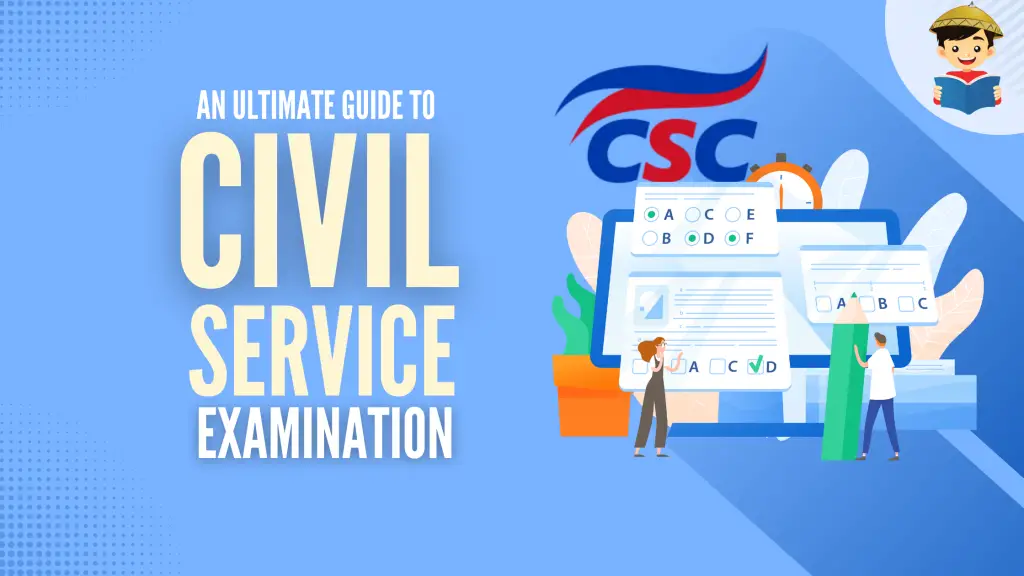
Would you rather work abroad or stay here and land a stable government job by passing the civil service exam?
Considering most Filipinos are family-oriented, it won’t surprise me if you choose the latter.
Just look at Jobstreet’s October 2017 survey: Almost 80% (or 8 out of 10) of the 16,425 respondents expressed their desire to work in the government1.
This proves that most Filipinos would rather work here than be away from their families when given a chance.
With all the benefits associated with a career in public service, it’s easy to see why Filipinos prefer it over the regular 9-to-5 office job.
On top of the fulfillment you derive from serving the Filipino people, you’ll also enjoy the following:
- Job security
- Competitive salary
- Career growth
- Retirement plan
- Bonuses and salary increases
Of course, everyone who desires to work for the government goes through a hiring process.
Nope, I’m not talking about finding an influential person to provide you with a shortcut; even the best “backer” can’t guarantee a government position if you don’t have civil service eligibility.
Civil service eligibility means you’ve passed the civil service exam.
And if you think this exam is only done for formality, let its dismal passing rate2 prove to you how difficult it is (at least for the majority of the examinees who end up not passing the exam).
In this definitive guide for Filipinos, you’ll learn everything you need to know to take and successfully pass the civil service exam.
Related: The Ultimate Civil Service Reviewer (with Free Practice Tests + Answer Keys)
Table of Contents
Watch Video: How To Pass the Philippine Civil Service Exam
Latest Civil Service Exam Updates and Schedules (2023)
- The 2023 Civil Service Exam Pen and Paper Test (CSE-PPT) is scheduled on March 26, 20233. The expected release of test results will be on May 25, 2023.
- For those who were supposed to take the postponed March 15, 2020, CSE-PPT, you can take the March 26 exam if you did not ask for a refund and you submitted the requirements during the special application period last December 14 – 21.
- There is still no recent update on the schedule of the CSC Computerized exam.
What Is a Civil Service Exam?
The civil service examination is administered by the Civil Service Commission (CSC) to determine who is fit to work for the government.
It is given multiple times a year and can be taken through one of two different modes:
- Paper and pencil test (CSC-PPT) or ballpen-based.
- Computerized examination (CSC-COMEX).
The mode of examination you’ll choose largely depends on whether you’re tech-savvy.
If you’re more comfortable flipping pages, shading circles on paper, and having the chance to change your answers whenever you want to, then the traditional mode is more appropriate for you.
However, if taking computer-based exams is right up your alley, and if you want to get results quicker, then the computerized examination (COMEX) is a better choice.
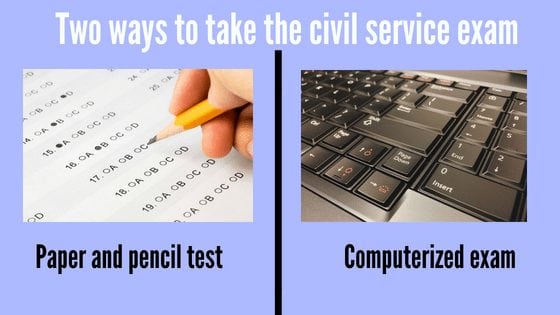
The COMEX is a recent innovation that offers a faster, easier, and more efficient way to take the civil service exam.
It is made possible by CSC with the help of the Advanced Science and Technology Institute (ASTI), the research and development arm of the Department of Science and Technology (DOST).
In some cases, however, such as the 2020 pandemic that upended almost all government procedures and transactions, the pen and pencil paper test is postponed to ensure the safety of the examinees. The latter is replaced by online civil service exams to be conducted more than twice a year, as the logistics of exams conducted online are less complicated than those of traditional examinations.
Take note that this online civil service exam differs from the computerized exam (COMEX) that applicants can take at regional CSC offices.
As of October 2020, the Civil Service Commission (CSC) is also considering lowering the passing grade and allowing Filipinos abroad to take the exams online.
The civil service exam can also be classified in terms of the type of eligibility it confers:
Subprofessional civil service exam.
Upon passing this exam, you’ll get the Career Service Subprofessional Eligibility which qualifies you for government-wide first-level positions that require less than four years of a college education. These include clerical, trades, crafts, and custodial service positions.
The subprofessional civil service exam covers English, Mathematics, General Information, and Clerical Operations. It has 165 items, and you’ll be given 2 hours and 40 minutes to finish the exam.
Professional civil service exam.
This relatively more difficult exam will provide you with Career Service Professional Eligibility which qualifies you not just for first-level positions but also for second-level scientific, technical, and professional positions up to the Division Chief level, all of which require at least a bachelor’s degree (four years of college education).
The professional civil service exam covers English, Mathematics, General Information, Analogies, and Logical Reasoning. It has 170 items, with 3 hours and 10 minutes allocated for the examination.
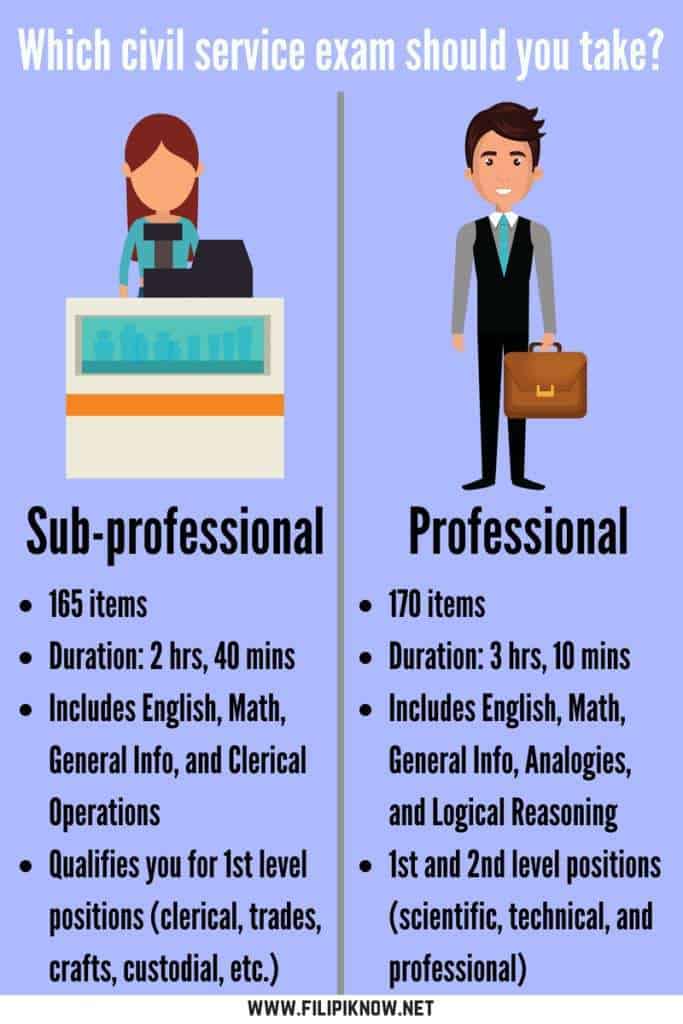
Because of the difficulty of the professional-level exam, taking the sub-professional exam first may sound like a piece of good advice.
However, taking the sub-professional exam can waste time and resources if you’re a college graduate applying for a second-level government position.
As long as you review and prepare well, you can easily pass the professional civil service exam and land your dream job in a shorter amount of time.
Who Can Take the Civil Service Exam?
According to the Civil Service Commission, interested applicants must meet the following qualification requirements before being allowed to take the exam:
a. Filipino citizen.
b. At least 18 years old (on the date of filing of the application).
c. With good moral character.
He/she has not been convicted by final judgment of crimes related to drug addiction, drunkenness, dishonesty, moral turpitude, and/or examination irregularity.
Applicants with pending criminal or administrative cases may still take the exam and be conferred civil service eligibility if passed.
However, once proven guilty, the eligibility can be forfeited as part of the penalties indicated in the decision of existing Civil Service Law.
d. If the applicant previously worked in the government, he/she has not been dishonorably discharged or dismissed from military service or civilian position.
e. Has not taken the civil service exam, whether through the pencil and paper test or computerized examination, within the last three months before the examination date.
f. Filipinos with dual citizenship may also apply and take the civil service exam if they present the original and submit a copy of the Certification of Retention/Reacquisition of Philippine Citizenship from the Bureau of Immigration.
The Civil Service Commission strictly complies with its rules.
If the application has already been processed and grounds for disqualification are discovered later on, the applicant will be prohibited from taking the exam, and the fees paid shall be forfeited.
Civil Service Exemption: Who Is Exempted From the Civil Service Exam?
Although passing the civil service exam is required before one can work in the government, it’s not the only pathway to getting civil service eligibility.
Some individuals can acquire the same eligibility without taking the civil service exam.
Under special laws, the Civil Service Commission grants 11 different eligibility categories4 to qualified individuals, automatically exempting them from taking the exam. They are the following:
a. College graduates who passed the bar and licensure board examinations administered by the Supreme Court and the Professional Regulation Commission, respectively.
b. Barangay health workers with college degrees (completed at least 2 years of college education), accredited by the Local Health Board, and have voluntarily rendered service to the community for at least 5 years.
c. Barangay nutrition scholars or volunteer workers who have rendered at least 2 years of continuous nutrition services and other related activities like family planning, mental feeding, backyard food production, sanitation, and community health.
d. Barangay officials who have completed their terms of office. These include elected officials such as the Barangay Captain, Sangguniang Kabataan Chairman, Sangguniang Barangay regular members, and the Barangay Treasurers and Secretaries appointed by the Barangay Captain.
e. Individuals who have passed the training courses or proficiency tests on Systems Analysis and Design and/or Computer Programming courses (Visual Basic, Java, or MS Access) conducted by the Information and Communications Technology Office (ICTO).
f. Those who graduated with Latin honors (summa cum laude, magna cum laude, or cum laude) from a reputable foreign school verified by the DFA.
g. Those who graduated with Latin honors (summa cum laude, magna cum laude, or cum laude) from a reputable private educational institution or state/local college or university in the Philippines.
h. Those who served as vice mayor and vice governor as well as regular Sanggunian Members of the Sangguniang Bayan, Sangguniang Panlungsod, and Sangguniang Panlalawigan. The level of government position you’ll be eligible for depends on the years you served as a Sanggunian Member and the number of units you completed to earn a bachelor’s degree.
i. Science and Technology Specialists who earned a bachelor’s degree in any of the accepted fields of specialization and who furthered their intellectual pursuits either by earning a master’s/doctorate or by getting at least three years of continuous research/teaching experience.
j. Skilled workers who completed at least 1 year of very satisfactory work performance and whose qualifications aren’t measurable by written tests. These include laboratory technicians, plumbers, draftsmen, carpenters, shrine curators, plant electricians, automotive mechanics, and heavy equipment operators.
Take note, however, that skills eligibilities aren’t similar or equivalent to either subprofessional or professional career service eligibilities.
Apart from the above-mentioned individuals, it’s also worth noting that veterans are entitled to a unique “career service” advantage.
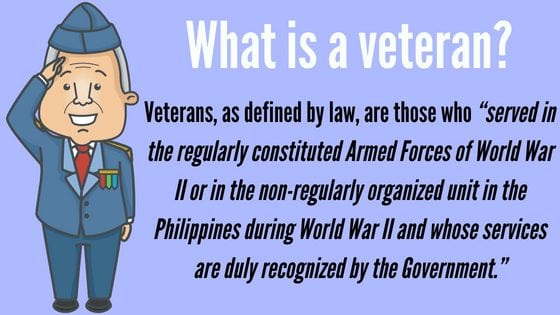
Under the Veteran Preference Rating Eligibility (VPRE), veterans, their spouses, and any of their children can receive 10 points to be added to their failed exam rating, which should not be lower than 70.
Thus, the VPRE can help veterans (or their dependents) obtain civil service eligibility despite failing in any one of these examinations:
- Fire Officer
- Penology Officer
- Career Service Professional
- Career Service Subprofessional
What Are the Civil Service Exam Schedules?
For the Paper and Pencil test (CSC-PPT), the Civil Service Commission conducts examinations twice a year, usually in March and August.
The Civil Service Commission Regional and Field Offices start accepting and processing applications a few months before the examination.
For example, applications for the March exam are accepted from November of the previous year up to the last day of January. Meanwhile, those who prefer to take the August civil service exam must file their applications any time between May and June.
There’s a limit to how many applicants can take the exam in both schedules. In other words, applications are processed on a first-come, first-served basis, proving the importance of filing your applications early.
Take note that these schedules may change without prior notice. To be aware of the latest civil service exam schedules, you can follow CSC through its website or official Facebook page.
The computerized examination (CSC-COMEX), on the other hand, is administered by CSC through its Central Office or any of its several Regional Offices.
In its Central Office, the COMEX-professional level exam is conducted several days throughout February, April, May, and June. The schedule of the sub-professional exam is only limited to two days.
The CSC Regional Offices use almost the exact schedules for the professional-level exam. The Sub-professional exam, in contrast, is only scheduled for one day.
Again, these schedules are subject to changes.
To view the latest COMEX schedules and reserve a slot for your preferred exam date, please visit the official CSC-COMEX “Examination Schedule” page.
Civil Service Exam Requirements
Interested individuals are expected to prepare the following requirements before applying for the civil service exam:
1. Fully Accomplished Civil Service Exam Application Form
Or the latest version of CS Form No. 100 (Revised 2016). You can download the form from the official CSC website and print it using a legal size bond paper.
Reminder: Leave the spaces for “Signature over Printed Name of Applicant” and “Right Thumbmark” blank. You can only accomplish them in the presence of a CSC processor.
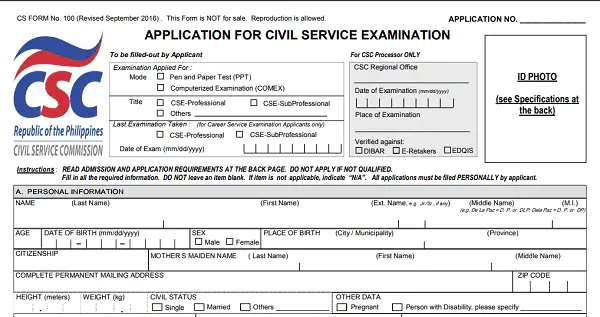
2. Four (4) Pieces of Identical ID Pictures
The pictures must have the following specifications:
- Passport size (1.8 inches x 1.4 inches or 4.5 cm x 3.5 cm)
- Colored
- On a white background
- Taken within three months before the filing of the application.
- Printed on high-quality photo paper.
- Close-up shot with head and face occupying 80% of the picture and with the name tag placed approximately 1 inch below the chin.

- The name tag must be handwritten and legibly showing the applicant’s signature over the printed full name following this format: First Name, Middle Initial, Last Name, and Extension Name (if any).
- Facial features should not be computer enhanced.
- Eyeglasses, contact lenses, and other accessories that may cover facial features aren’t allowed.
- Left and right ears must be visible.
- Full-face view with the applicant directly facing the camera.
- Both eyes should be open.
- Neutral facial expression.
3. Original and Photocopy of Any Valid (Not Expired) ID Card
It should show the applicant’s complete name, date of birth, clear picture, signature, and signature of the issuing agency’s head or representative.
Here’s a list of acceptable ID cards:
- Driver’s license
- BIR ID (either the ATM type or the TIN card with picture)
- Philippine Identification (PhilID) Card
- Philippine Passport
- PRC License
- SSS ID/GSIS ID/UMID
- Voter’s ID
- Philhealth ID
- Police Clearance or Police Clearance Certificate
- NBI Clearance
- Postal ID
- Current Company ID (for employees) or school I.D. (for students)
- Barangay ID
- Seaman’s Book
- Solo Parent ID
- PWD ID
- HDMF Transaction ID
- Senior Citizen’s ID
- CSC Eligibility Card
Any other ID card not included in the above list shall not be accepted.
Expired ID cards may be presented upon the filing of the application given that its expiry date falls on any date in CY 2022.
If you don’t have a valid ID that shows your date of birth, you are also required to present an original and photocopy of your Birth Certificate printed on Security Paper (SecPa) and issued either by the Philippine Statistics Authority (formerly NSO) or the Local Civil Registry (LCR).
4. Original and Photocopy of Your Certification of Retention/Reacquisition of Philippine Citizenship (if Applicable)
Issued by the Bureau of Immigration, this document is required from applicants with dual citizenship (under R.A. 9225) who must prove their eligibility to take the exam.
5. Examination Fee
Php 500 (Paper and Pencil Test); Php 680 (Computerized Examination).
6. Copy of the Appointment Letter Sent to Your Email (if Applicable)
This is only applicable to applicants taking the Computerized Exam or COMEX.
7. Only for Dual-Citizenship Applicants: Bureau of Immigration Identification Certificate (IC)
How Can I Apply for the Civil Service Exam?
A. Paper and Pencil Test (CSC-PPT) or Ballpen-Based Exam
Step 1: Download the application form or CS Form No. 100 (Revised 2016). Fill in all the requested information except your signature and thumbprint.
Step 2: Go to the nearest CSC Regional Office (CSCRO) or any of the CSCRO’s Field Offices and personally submit your application.
For every region, there are different field offices. From these field offices, you can pick one that is most accessible to you.
For example, I live in Bocaue, Bulacan, part of Region III. Since the regional office is in Pampanga, I can submit my application to the nearest field office in Malolos, Bulacan.
To see the complete CSC Regional and Field Offices where you can file your application, check the CSC Office Directory.
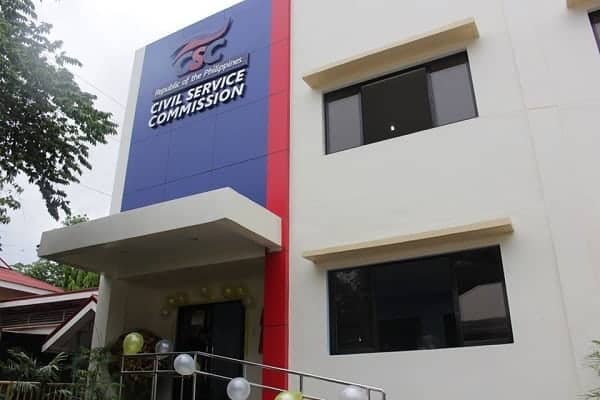
Wear proper attire on the day of your application. Sleeveless shirts/blouses, slippers, and short pants aren’t allowed.
Again, each office has a quota for the number of examinees they can accept. They receive and process applications on a first-come-first-served basis.
Since applications are received as early as 4 months before the examination date, it will be advantageous if you submit yours during this time so you can have a longer preparation period.
Step 3: Affix your signature and thumbprint on the application form in the presence of a CSC processor or Action Officer.
Step 4: Submit the application form for review.
If you’re qualified to take the civil service exam, the application form will be returned so you can proceed to the cashier to pay the examination fee (Php 500). Otherwise, you will be informed of why you’re disqualified from taking the test.
Step 5: Return to the Action Officer with the official receipt and your processed application form. You will then receive the examination receipt slip and important examination reminders.
B. Computerized Examination (COMEX)
Step 1: Access the CSC-COMEX website and click the “Sign Up Now!” button to create your account.

Note: Due to the website’s lack of an SSL certificate (i.e., the “https” before the site URL), some users may encounter a privacy error page after clicking the sign-up button (see screenshot below).
To access the next page, click “Advanced” and then “Proceed to www.comex.csc.gov.ph (unsafe).”
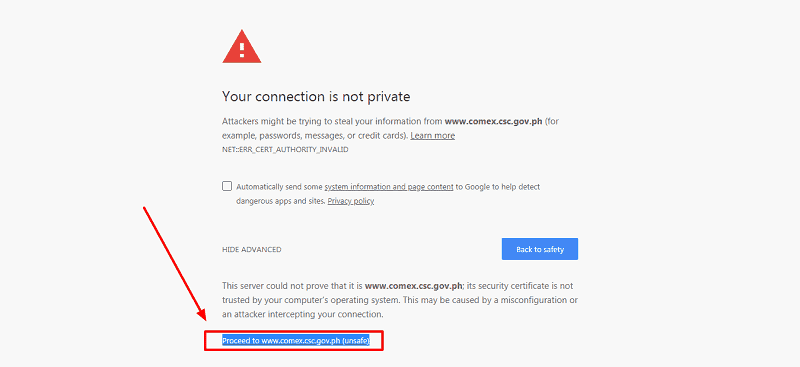
Create a username and password and fill in all the requested information on the succeeding pages. These include personal, educational, employment, eligibility, and other information.
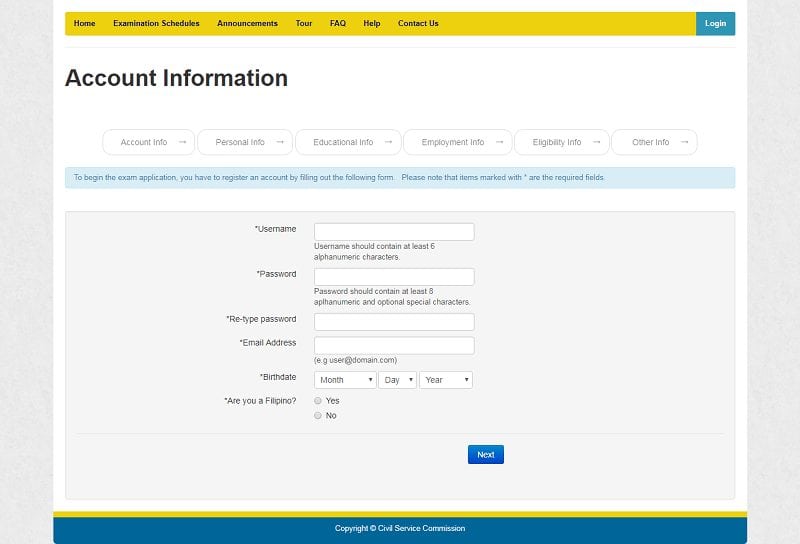
Note: When asked about your address, provide the full spelling instead of the abbreviation of the word “Barangay.” The abbreviated “Brgy.” will prompt an error message warning you not to use special characters.
Step 2: Read the “Terms and Conditions” and check the box below it once you’re done. You may also mark the subsequent box if you want to receive email updates regarding the examination schedules and newsletters.
Type in the captcha code to the designated box. Click the “Submit” button to complete the registration.
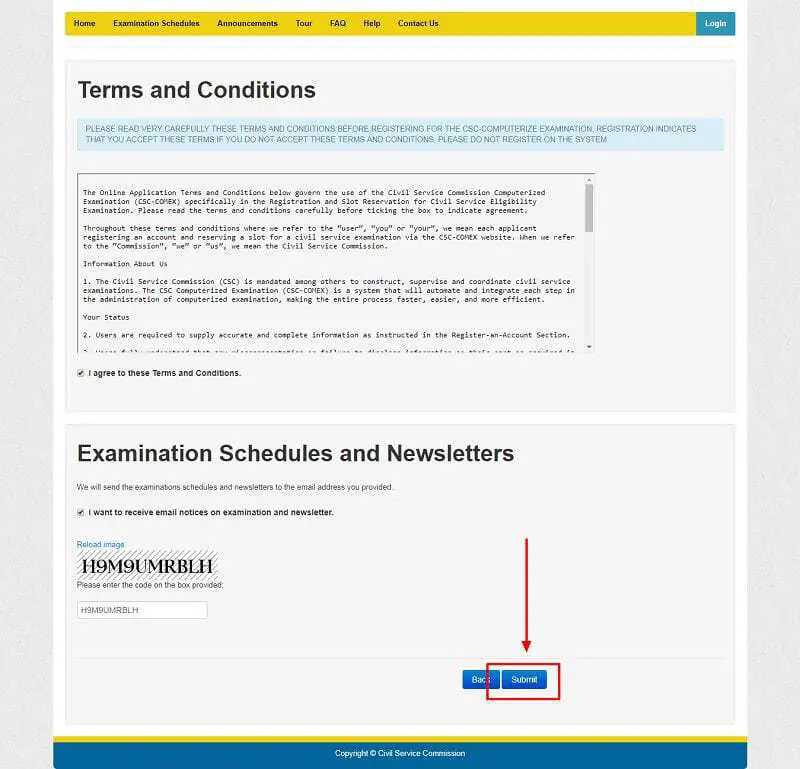
Step 3: Click the verification link to your email to activate your COMEX account.
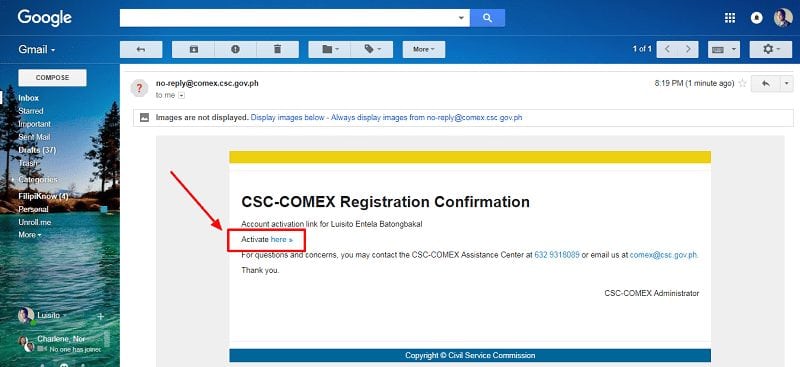
Step 4: Log in to your account with your username and password.
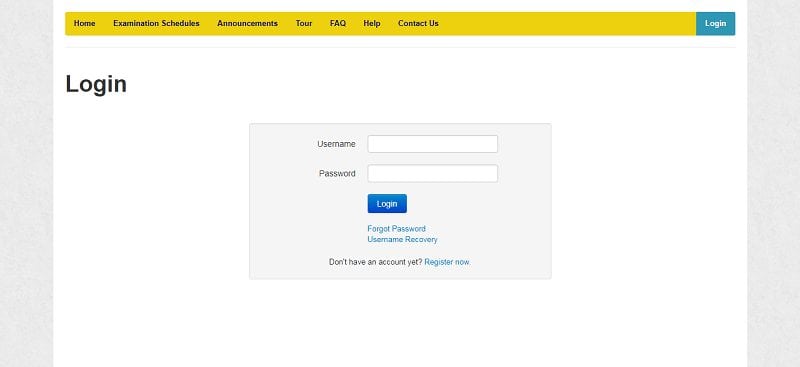
Step 5: On the next page, click the “Reserve a Slot Now!” button to view the examination schedules.

Step 6: Select your preferred testing center and examination date. You can also use the search filter above the page to limit the results to the specific examination date, testing center, examination type, and all available slots.
If your desired examination venue and schedule are available, click “Reserve a slot” or “View Details” to get more info about the selected item.
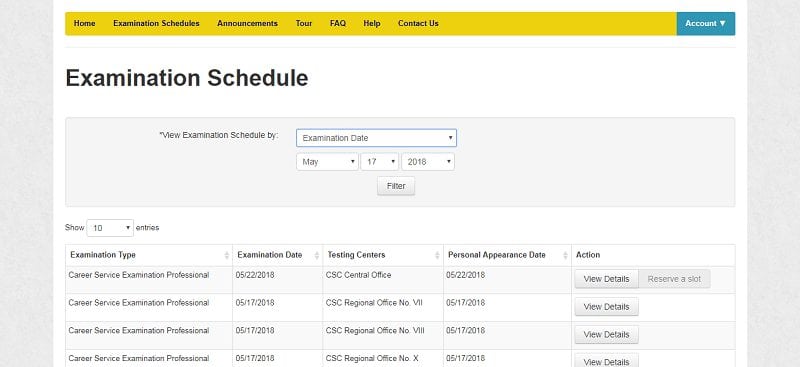
Step 8: Print the “slot reservation” confirmation sent to your email. Bring this on the day of the examination.
Civil Service Exam Coverage: What Is the Scope of the Civil Service Exam?
As previously mentioned, there are two levels of the exam that you can choose from: sub-professional and professional.
If you take and pass the sub-professional civil service exam, you’ll be qualified for first-level government positions (think clerical jobs).
Meanwhile, if you choose to take the professional civil service exam (as most of us do), you’ll be qualified for both first-level and second-level positions that require a bachelor’s degree.
The professional-level exam is relatively more difficult than the sub-professional. The former also has more items and a longer time allotment.
The table below shows the scope of each type of civil service exam:
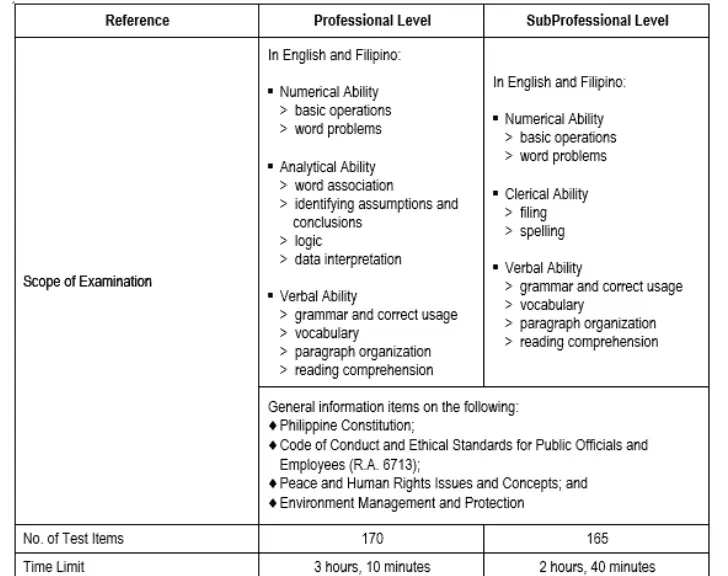
As you can see, both exams have questions about Verbal Ability, Numerical Ability, and General Information written in either English or Filipino.
The main difference is that the Sub-professional exam has questions on Clerical Ability (30-40 items) which test the examinee’s knowledge about basic tasks like filing, alphabetizing, etc.
The professional civil service exam, on the other hand, has items that test one’s Analytical Ability. These are questions (30-40 items) about logic, data interpretation, word association, single- or double-word analogy, etc.
In addition, both exams also include 20 Personal Information Questions, which are usually asked at the beginning.
Related: The Ultimate Civil Service Reviewer (with Free Practice Tests + Answer Keys)
How Can I Take the Civil Service Exam?
A. Paper and Pencil Test (CSC-PPT) or Ballpen-Based Exam
Step 1: Find out where you’ve been assigned to take the exam
CSC usually administers the civil service exam in its various offices or public elementary and high schools throughout the country.
Access the Online Notice of School Assignment (ONSA) to know your exam venue.

Fill in all the requested information in the corresponding fields. Once your Notice of School Assignment is displayed, print it out (no need to download it) and bring it on the day of your examination.
If you experience an error, ensure you’ve entered all the requested data in the right format.
For instance, a common mistake made by applicants is typing their full middle names instead of just their middle initials in the third box.
Alternatively, wait for a text message from CSC informing you about the exam venue.
If you can’t access the ONSA or fail to receive an SMS a week before your scheduled exam, call the CSC Regional or Field Office where you filed your application (see CSC Office Directory for a complete list of their contact details).
Step 2: Visit your examination venue a day or two before the exam.
Familiarize yourself with the location and estimated travel time. This will help you make the necessary adjustments to get there on time.
Step 3: Wake up early and go to the test venue on exam day.
The gates of the venue are usually open from 6 A.M. to 7:30 A.M. Those who will arrive later than 7:30 A.M. won’t be allowed to enter the venue and take the exam.
Follow the dress code. Individuals who wear short pants, sleeveless shirts/blouses, and slippers may be denied entry to the venue.
What to bring:
a. Application Receipt with CSC Official Receipt (if available).
b. A printed copy of your Notice of School Assignment. Note that this is only applicable if you can access and print the notice via ONSA. Otherwise, you can still take the exam without it if you provide all the other requirements listed here.
c. Black ballpen/s.
d. Water or your preferred beverage (except alcohol) placed in a clear bottle or container. You can also bring something to eat like biscuits or candies. Every food item you’ll bring shall be subject to inspection by the proctor or room examiner.
e. Original and photocopy of your I.D. card, ideally the same one you presented while filing your application. If you provide the same I.D. card, it will be accepted regardless if it has already expired or not.
If you lost or forgot the I.D. card you initially presented, you can choose from the list of I.D. cards below, but this time only valid and not expired cards can be accepted:
- Passport
- Voter’s ID
- GSIS ID (UMID)
- Driver’s License
- PRC License
- SSS ID
- BIR ID (ATM type or TIN card type with picture)
- NBI Clearance
- Police Clearance or Police Certificate
- Postal ID
- Barangay ID
- Company or Office ID
- Student ID (validated for current school year/semester/trimester)
- Philhealth ID (showing your Philhealth number, clear picture, full name, and signature)
Never forget your I.D. card because CSC strictly follows its NO I.D., NO EXAMINATION policy.
f. As before, if none of your I.D. cards show your date of birth, you also need to bring an original copy of your Birth Certificate printed on Security Paper and issued by the Philippine Statistics Authority (formerly NSO).
What NOT to bring inside the testing room:
Printed materials and gadgets that may aid in answering the exam. These include mobile phones, calculators, books, dictionaries, smartwatches, and tablets, to name a few.
All of these things must be kept in your bag and then surrendered to the room examiner before the start of the exam. You may retrieve them later on upon leaving the room.
Step 4: Answer the exam.
You’ll be given three documents to accomplish:
- Picture-seat plan.
- Examinee attendance.
- Answer sheet.
Your room examiner or proctor will provide instructions on accomplishing these forms.
The answer sheet is for the exam itself.
Only use a black ballpen to shade the circles that correspond to your answers.
Avoid using a sign pen, fountain pen, friction pen, or pens with colors other than black.
Shade the circles neatly and completely. You’re allowed to change the answer only once for every test item. When changing the answer, put an “X” mark over the initial answer and shade the new and final answer.
Don’t use a pen eraser, correction tape, correction pen, or correction fluid.
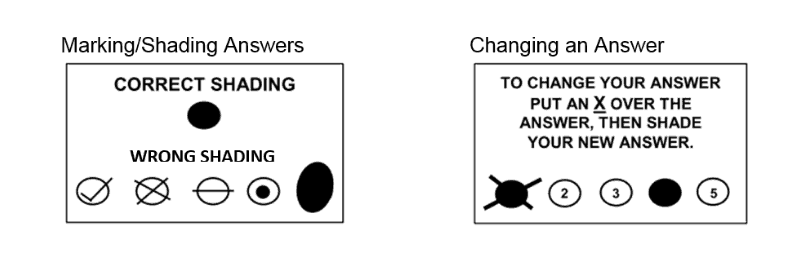
Avoid making stray or unnecessary marks on the test papers.
Finally, don’t stand to submit your test papers when you’re done. The proctor or room examiner will simultaneously collect all the answer sheets and test booklets from all examinees after the allotted time.
Once done, the proctor will inform you when it’s time to leave the room.
B. Computerized Examination (COMEX)
Step 1: Show up at the testing venue on the date and time of your examination. Get a queue number from the guard on duty.
Step 2: Submit the required documents to the processing area for verification. Present original and photocopy of any valid IDs accepted by CSC:
- Passport
- Voter’s ID
- GSIS ID (UMID)
- Driver’s License
- PRC License
- SSS ID
- BIR ID (ATM type or TIN card type with picture)
- NBI Clearance
- Police Clearance or Police Certificate
- Postal ID
- Barangay ID
- Company or Office ID
- Student ID (validated for current school year/semester/trimester)
- Philhealth ID (showing your Philhealth number, clear picture, full name, and signature)
As with the paper-and-pencil test, COMEX examinees who don’t have I.D. cards that show their date of birth are also required to bring an original and photocopy of their Birth Certificate issued either by the Local Civil Registry or the Philippine Statistics Authority.
Step 3: Proceed to the cashier to pay the exam fee. As of this writing, COMEX costs Php 680.
Step 4: Present the official receipt to the CSC processor or action officer.
Step 5: Get your CSID and proceed to the waiting room
Step 6: After listening to the orientation/briefing by the proctor/room examiner, sign the picture-seat plan and the examinee attendance sheet
Step 7: Take the exam
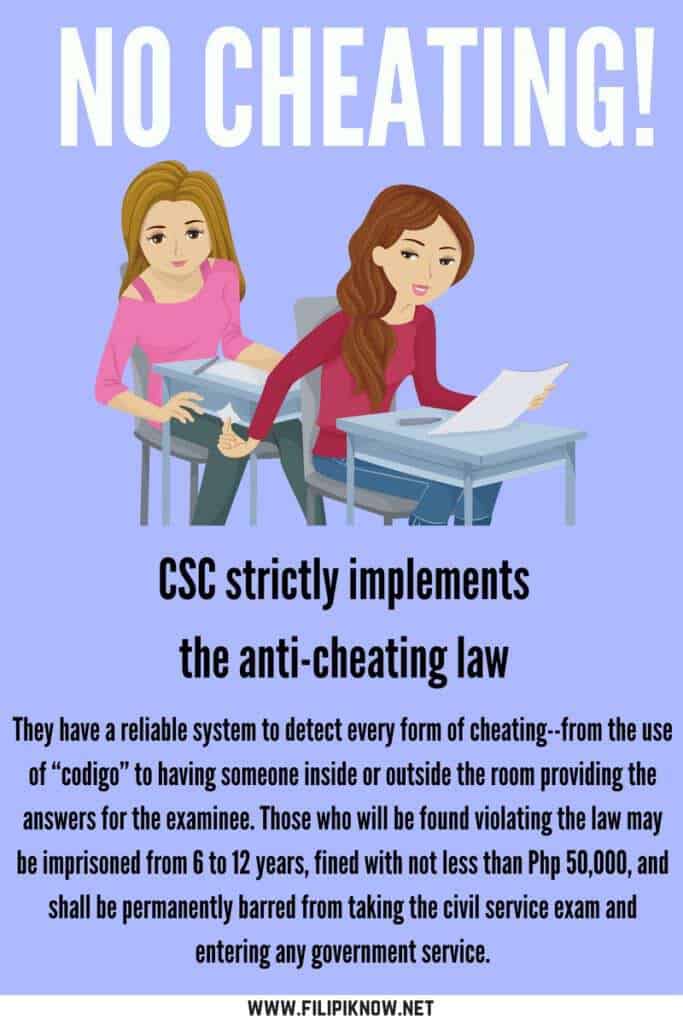
What Is the Civil Service Exam Passing Score?
To get civil service eligibility, examinees must obtain a passing score of 80.00 or above.
How Long Does It Take To Get a Civil Service Exam Result?
A. Paper and Pencil Test (CSC-PPT) or Ballpen-Based Exam
Due to the nature of the exam, CSC-PPT takes longer to generate results.
On average, the official List of Passers is uploaded/posted on the CSC website within 60 days after the examination. For March 2023 exam, the target release date will be on May 25, 2023.
On the other hand, the Examination Rating won’t be available until approximately 15 days after the List of Passers is released.
You can get your Examination Rating using the Online Civil Service Examination Result Generation System (OCSERGS), which can also be accessed through the CSC website.
As proof that you have passed the exam, a Certification of Eligibility will be given to you approximately 30 days after the release of the official List of Passers on the CSC website.
To claim your Certification of Eligibility, go to your respective CSC Regional Office and present the following:
a. Application receipt (if available).
b. At least one valid I.D., preferably the same identification card you presented during the filing of your application, regardless if it has already expired or not. Otherwise, you can show any valid I.D. provided it’s valid or not yet expired.
The valid ID must have your name, clear picture, date of birth, signature, and signature of issuing agency’s current head or representative. Only the following valid IDs are acceptable:
- Driver’s License
- GSIS ID
- Philippine Identification (PhilID) card
- Philhealth ID
- Company or School ID
- Postal ID
- BIR ID
- Barangay ID
- Police Clearance
- Voter’s ID
- Passport
Personal appearance is required as CSC won’t allow representatives to claim your Certification of Eligibility. You may also call your CSC Regional Office for other requirements that aren’t included above.
On the other hand, those who have failed the civil service exam can get a copy of their Report of Rating through the CSC website. Before you can obtain it, you will be required to enter the following information:
- Name
- Date of Birth
- Examinee Number
- Examination Type
- Examination Date
B. Computerized Examination (COMEX)
The advantage of taking the computerized civil service exam is you’ll be able to get the test result relatively quicker.
Just like in the traditional paper-and-pencil test, the results of the COMEX will also be posted on the CSC website. This time, the official List of Passers is released only one week after the exam.
Passers will be issued Certification of Eligibility, while those who have failed may request their Report of Rating through the CSC website.
What Happens Next After Passing the Civil Service Exam?
Filipinos pass the civil service exam to vie for permanent government positions, plain and simple.
If somehow you’ve changed your mind and applied for jobs in the private sector, the hiring managers may or may not find your civil service eligibility irrelevant. Even if you got a high score, they would probably put more weight on your educational achievements.
Besides, the civil service exam only gauges your basic skills and knowledge. If private companies want to measure your aptitude, they have exams that can easily do the same.
Perhaps the only people who will find their civil service eligibility useful are those applying for higher positions in the private sector. Even then, they’ve probably already taken the CESO (Career Executive Service Officer), which is a notch higher than the basic professional civil service exam.
A CESO certification is proof of your managerial skills and knowledge which you can easily apply to your new position.
Passing the civil service exam doesn’t give you an easy ticket to a government job either.
After all, thousands who pass the exam every year have to compete with each other for limited spots in the government.
A good rating doesn’t guarantee you’ll be hired on the spot, nor gives HR any clue about your managerial/leadership skills, work ethic, and personality.
Worse, most of the permanent positions–also known as plantilla positions–are often occupied by employees who are enjoying the security of tenure. Unless these people retire, resign, or are dismissed from their positions, then there will be no vacant spots to fill in the first place.
Nonetheless, acing the civil service exam is a good starting point.
It offers you an entry-level qualification.
Now it’s up to you how you’re going to use it.
Good luck!
Related: How to Pass Civil Service Exam in One Take: The Ultimate Guide to Test-Taking Hacks
References
- Filipino Want to Serve the Government | JobStreet.com PH Employer. (2019). Retrieved 21 October 2019, from https://www.jobstreet.com.ph/en/cms/employer/filipinos-show-desire-serve-philippine-government-jobstreet-com-survey/
- Roxas, P. (2018). Only 10.7% pass March 2018 civil service exam. Retrieved 21 October 2019, from https://newsinfo.inquirer.net/993218/only-10-7-pass-march-2018-civil-service-exam
- Examination Announcement No. 11, s. 2022 [PDF]. (2022, November 25). Civil Service Commission (CSC).
- M., M. Eligibilities Granted under Special Laws and CSC Issuances. Retrieved 21 October 2019, from http://www.csc.gov.ph/2014-08-26-07-36-12/eligibilities-granted-under-special-laws-and-csc-issuances.html
FilipiKnow
FilipiKnow strives to ensure each article published on this website is as accurate and reliable as possible. We invite you, our reader, to take part in our mission to provide free, high-quality information for every Juan. If you think this article needs improvement, or if you have suggestions on how we can better achieve our goals, let us know by sending a message to admin at filipiknow dot net
Copyright Notice
All materials contained on this site are protected by the Republic of the Philippines copyright law and may not be reproduced, distributed, transmitted, displayed, published, or broadcast without the prior written permission of filipiknow.net or in the case of third party materials, the owner of that content. You may not alter or remove any trademark, copyright, or other notice from copies of the content. Be warned that we have already reported and helped terminate several websites and YouTube channels for blatantly stealing our content. If you wish to use filipiknow.net content for commercial purposes, such as for content syndication, etc., please contact us at legal(at)filipiknow(dot)net